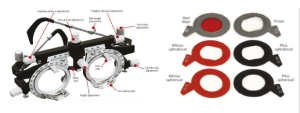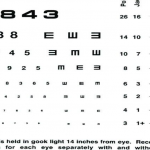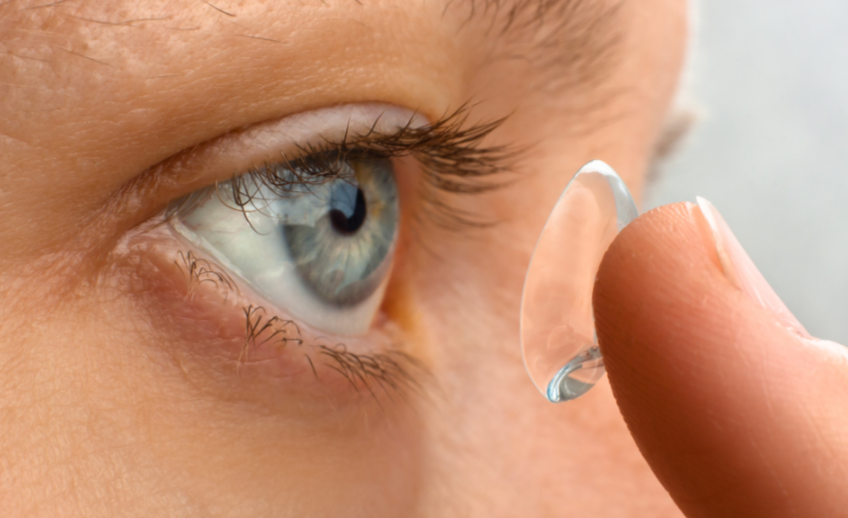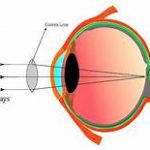Before we delve into the components of a trial lens case, we have to understand what it is and what it is used for. So what is a trial lens case? What is it used for?
A trial lens case is simply a mobile phoropter with some additional advantages that is used as a tool for eye examination used regularly by both optometrists and ophthalmologists. It is a box containing lenses, prisms and accessories that are basically used for refractive, accommodative and binocular tests/assessment in additional to many supplementary tests which gives it a slight edge over the conventional phoropter.
The only major advantage that the conventional phoropter has over the trial lens case is the fact that the phoropter, though fixed was designed to be automated (with every in place already) with the practitioner being only required to make some adjustments to the automated to suit the test that is to be carried out. Whereas, the trial lens case, though mobile, is designed to be completed manual (from putting every in place to constant/specific adjustment depending on the test to be performed).
Now that we have understood what a trial lens case is, its purpose, advantage and disadvantage, let delve into its components and their uses.
There are several parts of the trial lens case and each of them serve a specific purpose. These includes:
Spherical lenses: These includes a pair of positive and negative lenses ranging from ±0.12D to ±20D respectively. It is used to check for refractive errors, determine spherical ametropia and hand neutralization of spherical component in lenses
Cylindrical lenses: These includes a pair of positive and negative lenses ranging from ±0.12D to ±6D respectively. It is used to determine and check for astigmatism as well as hand neutralization of cylindrical component in lenses.
Prismatic lenses: These includes prismatic lenses ranging from 0.50Δ to 8Δ. They are used to measure, exercise or correct deviations (latent and manifest), as well as fusional, accommodative and dissociating tests.
Occluder: This is an opaque plastic disc used to occlude one eye in order to carry out a test or therapy, break fusion in binocular vision and relax accommodation.
Pinhole: This is an opaque plastic disc with a 1-3mm diameter opening at its center. This opening allows only a pencil of light to pass through it. It creates a smaller blur circle on the retina, thereby improving VA and helps to differentiate a reduction/loss of vision in pathological and refractive cases. As VA may not be improved in the former (depending on the cause) but is usually always improved in the latter.
Stenopiac slit: This is an opaque plastic disc with a slit of 1mm width and 25mm in length at its center. This opening allows only a strip of light to pass through it. It is used to detect and determine astigmatism together with its corresponding axis and power as well as to perform Emsely Fincham’s test (halos differentiation test).
Color filter lenses: This consist of the red and green filters which usually filtration and dissociation of colors to detect diplopia and suppression as well as measuring fusion and squint.
Maddox rod: It consists of several series of high plus plano cylindrical lenses that forms and presents itself as a streak opposite to its orientation. It is used to detect an measure heterophoria and cyclophoria as well as their corresponding tropia.
Plano lens: This is a lens without power that is used as a control/placebo to detect malingering (Uncooperativeness) in patients during subjective tests.
Jackson cross cylinder: It is a combination of a plus and minus cylinder 90̊ apart which is held by a handle at 45̊ between both axes. It is used for both determining and refining astigmatism with its corresponding axis and power
Inter-pupillary distance ruler (IPD): It is used to measure the distance between the pupils which in turn helps in determining the optical center and a frame’s front face size.
Near Vision Chart: It is used to assess near visual acuity and refine a tentative presbyopic add.
Trial frame: This is an eyeglass frame worn in front of the face, that allows for the insertion of different lenses that serve different purposes. E.g carrying out tests, correcting refractive errors etc. It may or may not be adjustable and its IPD ruler may or may not be fixed.










